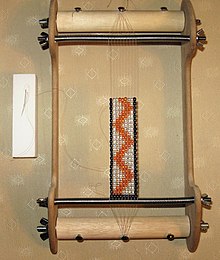Beadwork
Beadwork is the art or craft of attaching beads to one another by stringing them onto a thread or thin wire with a sewing or beading needle or sewing them to cloth.[1] Beads are produced in a diverse range of materials, shapes, and sizes, and vary by the kind of art produced. Most often, beadwork is a form of personal adornment (e.g. jewelry), but it also commonly makes up other artworks.

Beadwork techniques are broadly divided into several categories, including loom and off-loom weaving, stringing, bead embroidery, bead crochet, bead knitting, and bead tatting.[2]
Ancient beading[]

The art of creating and utilizing beads is ancient, and ostrich shell beads discovered in Africa can be carbon-dated to 10,000 BC.[3][4] Faience beads, a type of ceramic created by mixing powdered clays, lime, soda, and silica sand with water until a paste forms, then molding it around a stick or straw and firing until hard, were notably used in ancient Egyptian jewelry from the First Dynasty (beginning in the early Bronze age) onward.[5][6] Faience and other ceramic beads with vitrified quartz coatings predate pure glass beads.[7]
Beads and work created with them were found near-ubiquitously across the ancient world, often made of locally available materials. For example, the Athabaskan peoples of Alaska used tusk shells (scaphopod mollusks), which are naturally hollow, as beads and incorporated them into elaborate jewelry.[8]
Beadwork has historically been used for religious purposes, as good luck talismans, for barter and trade, and for ritual exchange.[4]
Modern beading[]

Today, beadwork is commonly practiced by jewelers, hobbyists, and contemporary artists; artists known for using beadwork as a medium include Liza Lou, Ran Hwang, Hew Locke, Jeffery Gibson, and Joyce J. Scott.[9]
Some ancient stitches have become especially popular among contemporary artists. The off-loom peyote stitch, for example, is used in Native American Church members' beadwork.[10]
European beadwork[]
Beadwork in Europe, much like in Egypt and the Americas, can be traced to the use of bone and shell as adornments amongst early modern humans.[3] As glassmaking increased in popularity through the Middle Ages, glass beads began to appear extensively in bead embroidery, beaded necklaces, and similar wares.[11]
By 1291, artists in Murano, Italy had begun production of intricate glass Murano beads inspired by Venetian glassware. With the advent of lampwork glass, Europeans started producing seed beads for embroidery, crochet, and other, mostly off-loom techniques.[7] Czech seed beads are among the most popular contemporary bead styles.

Beadwork is a central component of the traditional dress of many European peoples. In Northern Russia, for example, the Kokoshnik headdress typically includes river pearl netting around the forehead in addition to traditional bead embroidery.[12]
Native American beadwork[]

Native American beadwork, already established via the use of materials like shells, dendrite, claws, and bone, evolved to incorporate glass beads as Europeans brought them to the Americas beginning in the early 17th century.[13][14]
Native beadwork today heavily utilizes small glass beads, but artists also continue to use traditionally important materials. Wampum shells, for instance, are ceremonially and politically important to a range of Eastern Woodlands tribes, and are used to depict important events.[15]
Several Native American artists from a wide range of nations are considered to be at the forefront of modern American bead working. These artists include Teri Greeves (Kiowa, known for beaded commentaries on Native voting rights),[16] Marcus Amerman (Choctaw, known for realistic beaded portraits of historical figures and celebrities),[17] and Jamie Okuma (Luiseño-Shoshone-Bannock, known for beaded dolls).[18]
Great Lakes tribes[]
Ursuline nuns in the Great Lakes introduced floral patterns to young Indigenous women, who quickly applied them to beadwork.[19] Ojibwe women in the area created ornately decorated shoulder bags known as gashkibidaagan (bandolier bags).[20]
Eastern Woodlands tribes[]
Innu, Mi'kmaq, Penobscot, and Haudenosaunee peoples developed, and are known for, beading symmetrical scroll motifs, most often in white beads.[21] Tribes of the Iroqouis Confederacy practice raised beading, where threads are pulled taut to force beads into a bas-relief, which creates a three-dimensional effect.[22][23]
Southeastern tribes[]
Southeastern tribes pioneered a beadwork style that features images with white outlines, a visual reference to the shells and pearls coastal Southeasterners used pre-contact.[24] This style was nearly lost during the Trail of Tears, as many beadworkers died during their forced removal to Indian Terrirory west of the Mississippi River. Roger Amerman (Choctaw, brother of Marcus Amerman) and Martha Berry (Cherokee) have effectively revived the style, however.[24]
Sierra Madre tribes[]
Huichol communities in the Mexican states of Jalisco and Nayarit uniquely attach their beads to objects and surfaces via the use of a resin-beeswax mixture (in lieu of wire or waxed thread).[25]
African beadwork[]

Several African nations outside of Egypt have beadworking traditions. Aggry (also spelled aggri or aggrey) beads, a type of decorated glass bead, are used by Ghanians and other West Africans to make necklaces and bracelets that may be traded for other goods.[26] These beads are often believed to have magical medicinal of fertility powers. In Mauritania, powder-glass Kiffa beads represent a beading tradition that may date as far back as 1200 CE; a group of women have been revitalizing the craft after the last traditional Kiffa artisans died in the 1970s.[27] Cameroonian women are known for crafting wooden sculptures covered in beadwork.[28]
See also[]
- Glass beadmaking
- Murano beads
- Bead embroidery
References[]
- ^ "Beadwork". Merriam-Webster. Retrieved 3 May 2014.
- ^ Libin, Nina (1998). Tatted Lace of Beads, the Techniques of BEANILE LACE. Berkeley, CA: LACIS. p. 112. ISBN 0-916896-93-5.
- ^ Jump up to: a b Dubin, Lois Sherr (2009). The History of Beads: From 100,000 B.C. to the Present. New York: Harry N. Abrams. p. 16. ISBN 978-0810951747.
- ^ Jump up to: a b Sciama, Lidia D.; Eicher, Joanne B. (1998). Beads and Bead Makers: Gender, Material Culture and Meaning (Cross-Cultural Perspectives on Women). Bloomsbury Publishing. pp. 1–3. ISBN 978-1859739952.
- ^ Dee, Michael; Wengrow, David; Shortland, Andrew; Stevenson, Alice; Brock, Fiona; Girdland Flink, Linus; Bronk Ramsey, Christopher (8 November 2013). "An absolute chronology for early Egypt using radiocarbon dating and Bayesian statistical modelling". Proceedings of the Royal Society A: Mathematical, Physical and Engineering Sciences. 469 (2159): 20130395. doi:10.1098/rspa.2013.0395. ISSN 1364-5021. PMC 3780825. PMID 24204188.
- ^ Peck, William (2013). The Material World of Ancient Egypt. Cambridge University Press. ISBN 1107276381.
- ^ Jump up to: a b Dubin, Lois Sherr (2010). The Worldwide History of Beads: Ancient, Ethnic, Contemporary. Thames & Hudson. ISBN 9780500515006.
- ^ Dubin, Lois Sherr (2009). The History of Beads: From 100,000 B.C. to the Present. New York: Abrams. p. 463. ISBN 978-0810951747.
- ^ Gittlen, Ariela (16 February 2018). "6 Artists Turning Beads into Spellbinding Works of Art". Artsy. Retrieved 19 October 2020.
- ^ Steele, Meredith (23 May 2019). "Peyote Stitch: A Brief History". Interweave. Retrieved 22 July 2021.
- ^ Keller, Daniel; Price, Jennifer; Jackson, Caroline (2014). Neighbours and Successors of Rome: Traditions of Glass Production and use in Europe and the Middle East in the Later 1st Millennium AD. Oxbow Books. pp. 1–41. ISBN 978-1-78297-398-0.
- ^ "Headdress of Natalia de Shabelsky". Met Museum.
- ^ "Native American Art- Cherokee Beadwork and Basketry". nativeamerican-art.com. Retrieved 14 November 2017.
- ^ Cherokee, Eastern Band of. "Cherokee Indian Beadwork and Beading Patterns | Cherokee, NC". Cherokee, NC. Retrieved 14 November 2017.
- ^ Dubin, pp. 170–171
- ^ Lopez, Antonio (August 2000). "Focus on Native Artists | Teri Greeves". Southwest Art Magazine. Retrieved 13 March 2009.
- ^ Berlo and Phillips, p. 32
- ^ Indyke, Dottie (May 2001). "Native Arts | Jamie Okuma". Southwest Art Magazine. Retrieved 13 March 2009.
- ^ Dubin, p. 50
- ^ Dubin, p. 218
- ^ Berlo and Phillips, p. 146
- ^ Hoffman, Karen Ann. "Wisconsin Life, Iroquois Beadwork". Wisconsin First Nations.
- ^ Berlo and Philips, p. 151
- ^ Jump up to: a b Berlo and Phillips, p. 87
- ^ Hillman, Paul. "The Huichol Web of Life: Creation and Prayer | Lesson Two: Jicaras, Kukus and Seeds". Community Arts Resource Exchange. The Bead Museum. Archived from the original on 18 May 2008. Retrieved 13 March 2009.
- ^ Quiggin, A. Hingston (1949). A Survey of Primitive Money. London: Methuen & Co Ltd. pp. 36–44.
- ^ Simak, E. "Mauritanian Powder-Glass Kiffa Beads". Ornament. 5(29): 60–63.
- ^ LaDuke, Betty. (1997). Africa : women's art, women's lives. Trenton, NJ: Africa World Press. pp. 63–84. ISBN 0-86543-434-4. OCLC 35521674.
- Berlo, Janet C.; Ruth B. Phillips (1998). Native North American Art. Oxford History of Art. Oxford University Press. ISBN 978-0-19-284218-3.
- Dubin, Lois Sherr (1999). North American Indian Jewelry and Adornment: From Prehistory to the Present. New York: Harry N. Abrams. ISBN 0-8109-3689-5
- Dubin, Lois Sherr (2009). The History of Beads: From 100,000 B.C. to the Present. New York: Harry N. Abrams. ISBN 978-0810951747.
- Beads and beadwork. (1996). In Encyclopedia of north american indians, Houghton Mifflin. Retrieved 27 January 2014, from http://search.credoreference.com/
External links[]
| Wikimedia Commons has media related to Beadwork. |
| Wikivoyage has a travel guide for Bead shopping. |
- Beadwork
- Handicrafts
- Beadworkers
- Decorative arts

